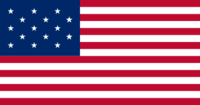 The Star-Spangled Banner flag was sewn by flag maker Mary Pickersgill with the help of her 13-year-old daughter and several others during the War of 1812. The massive garrison flag measured 30 feet by 42 feet and weighed approximately 50 pounds. The 15 stripes and the blue union were made from dyed English wool bunting, and the 15 stars were made from cotton. The 15 stripes and 15 stars were meant to represent all the states in the Union. Years later the number of stripes was reduced to 13 to represent the original 13 colonies.
The Star-Spangled Banner flag was sewn by flag maker Mary Pickersgill with the help of her 13-year-old daughter and several others during the War of 1812. The massive garrison flag measured 30 feet by 42 feet and weighed approximately 50 pounds. The 15 stripes and the blue union were made from dyed English wool bunting, and the 15 stars were made from cotton. The 15 stripes and 15 stars were meant to represent all the states in the Union. Years later the number of stripes was reduced to 13 to represent the original 13 colonies.
The flag was made for Lt. Col. George Armistead and commissioned to fly over Fort McHenry. It was raised over Fort McHenry in 1814 when America defeated the British at the Battle of Baltimore. Inspired by this sight, American lawyer Francis Scott Key wrote the "Star-Spangled Banner" poem. Later the poem was set to the tune of "To Anacreon in Heaven," a well known English song. By 1861 Key's song became widespread, and Americans began to see the American flag as a symbol of patriotism. The song became the offical National Anthem in 1931.
The Star-Spangled Banner flag is currently displayed at the Smithsonian Institution's National Museum of American History in Washington, DC. It belonged to the Armistead family for years and was passed down generation to generation. It came to the Smithsonian in 1907.
"The Star-Spangled Banner" by Francis Scott Key
Oh, say can you see, by the dawn's early light, What so proudly we hailed at the twilight's last gleaming? Whose broad stripes and bright stars, through the perilous fight, O'er the ramparts we watched, were so gallantly streaming? And the rockets' red glare, the bombs bursting in air, Gave proof through the night that our flag was still there. O say, does that star-spangled banner yet wave O'er the land of the free and the home of the brave?
On the shore, dimly seen through the mists of the deep, Where the foe's haughty host in dread silence reposes, What is that which the breeze, o'er the towering steep, As it fitfully blows, half conceals, half discloses? Now it catches the gleam of the morning's first beam, In full glory reflected now shines on the stream: 'Tis the star-spangled banner! O long may it wave O'er the land of the free and the home of the brave.
And where is that band who so vauntingly swore That the havoc of war and the battle's confusion A home and a country should leave us no more? Their blood has wiped out their foul footstep's pollution. No refuge could save the hireling and slave From terror of flight, or the gloom of the grave: And the star-spangled banner in triumph doth wave O'er the land of the free and the home of the brave.
Oh! thus it be ever, when freemen shall stand Between their loved homes and the war's desolation! Blest with victory and peace, may the heaven-rescued land Praise the Power that hath made and preserved us a nation. Then conquer we must, when our cause it is just, And this be our motto: "In God is our trust." And the star-spangled banner in triumph shall wave O'er the land of the free and the home of the brave!
Proper Procedure During the "Star-Spangled Banner"
Although the Star-Spangled Banner is not specifically mentioned in the Flag portion of the U.S. Code, it is mentioned in a much later chapter. Generally the proper procedure during the Star-Spangled Banner is the same as the procedure during the Pledge of Allegiance. The main difference is that the Pledge cannot be recited without the presence of an American Flag, while the Star-Spangled Banner can be sung without a flag present.
When a Flag is Present:
- Stand facing the flag with your right hand over your heart
- Men not in uniform should remove their hats
- Men & women in uniform should give the military salute during the entire song
When a Flag is Not Present:Face the music or singer, and follow procedure as if a flag were present.
References The Care and Display of the American Flag by the Editors of SharpMan 2004. Flag: An American Biography by Marc Leepson 2004. Fort McHenry: Birthplace of Our National Anthem A Service of Baltimore County Public Library 2000-2007. U.S. Code, Title 36, Chapter 3, Section 301. "Smithsonian's Star-Spangled Banner conservation Laboratory and Exhibition Open at National Museum of American History"National Museum of American History 1999
